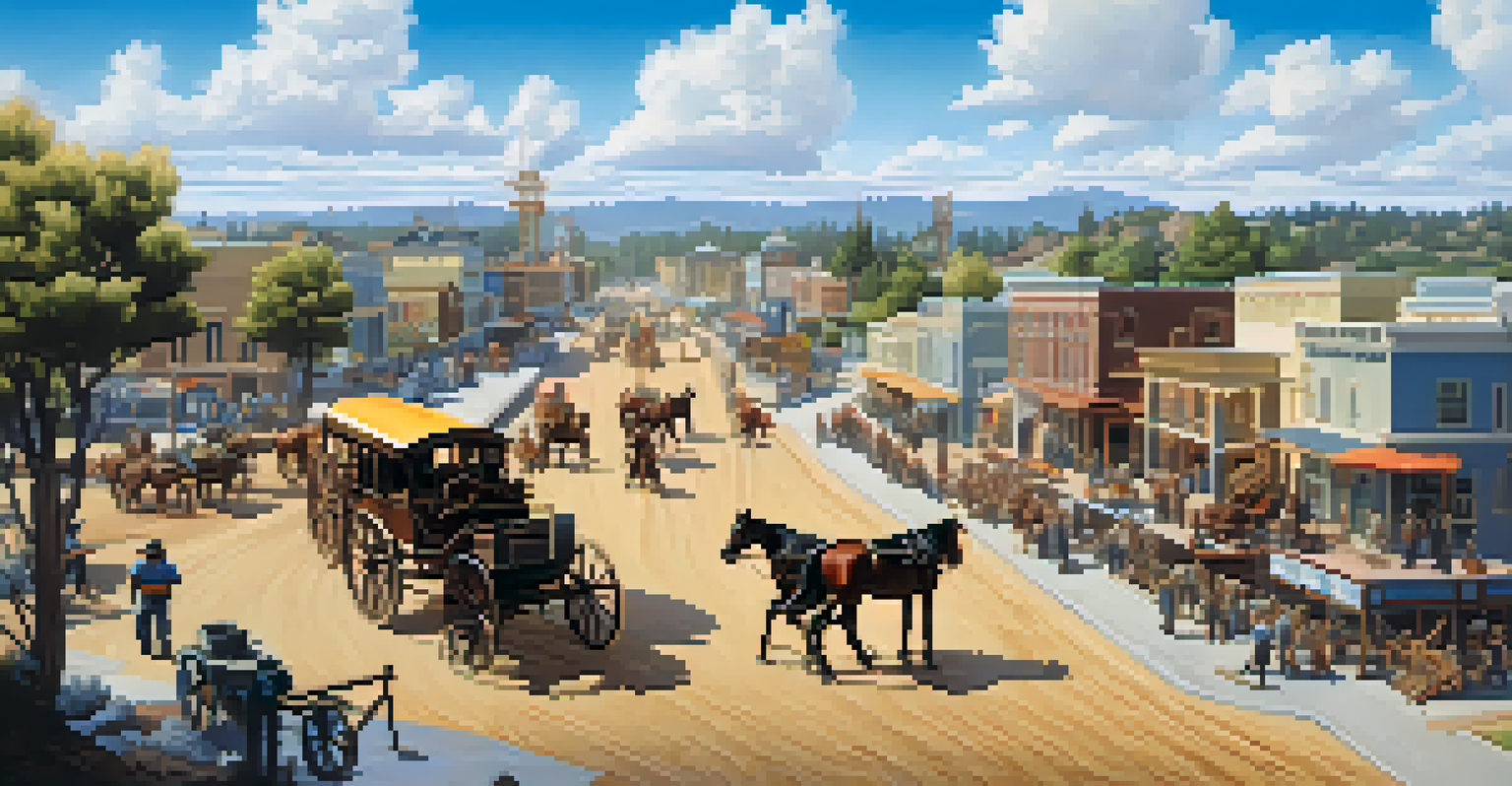The Gold Rush: How It Sparked Growth in Redwood City

The Gold Rush Begins: A Wave of Opportunity
In 1848, the discovery of gold at Sutter's Mill ignited a frenzy that would change California forever. People from all walks of life rushed to the state, seeking fortune and a new beginning. This massive influx of prospectors and entrepreneurs created a ripple effect, with towns like Redwood City emerging as vital support hubs in the gold rush economy.
The Gold Rush was a time of great opportunity, where dreams were forged in the fires of ambition.
Redwood City, with its strategic location along the San Francisco Peninsula, quickly became a key player in providing goods and services to those heading to the goldfields. The demand for supplies such as food, tools, and transportation skyrocketed, leading to a bustling marketplace that attracted merchants and tradespeople eager to capitalize on the opportunity.
The excitement of the Gold Rush was palpable, turning the sleepy coastal town into a vibrant center of activity. As news spread of newfound wealth, more settlers arrived, setting the stage for Redwood City's transformation from a quiet settlement to a thriving economic hub.
Infrastructure Development: Building for Growth
As the population surged, so did the need for infrastructure. Redwood City saw significant improvements in its roads, transportation, and public services to accommodate the growing community. The construction of new buildings, including stores, saloons, and hotels, reflected the town's burgeoning status.

The establishment of a reliable transportation network became crucial. Ferries, stagecoaches, and eventually railroads connected Redwood City to nearby regions, making it easier for gold seekers to access supplies and for merchants to ship goods. This connectivity not only facilitated trade but also integrated Redwood City into the broader economic landscape of California.
Gold Rush Transformed Redwood City
The Gold Rush sparked a massive influx of people and resources, turning Redwood City into a vital economic hub.
These infrastructure developments laid the groundwork for future growth. By investing in roads and transport, Redwood City positioned itself as a permanent fixture in the fabric of California's emerging economy, ensuring that it would thrive long after the Gold Rush ended.
A Diverse Community: Cultures Collide
The Gold Rush attracted a diverse array of people from across the globe. Immigrants from Europe, Asia, and Latin America flocked to California, each bringing their own cultures, traditions, and skills. In Redwood City, this melting pot of backgrounds contributed to a rich tapestry of community life.
In the midst of chaos, there is also opportunity.
As different cultures mingled, they influenced local customs, cuisine, and even business practices. This cultural exchange fostered an environment of innovation, with new ideas and perspectives shaping the town's development. Restaurants offering diverse cuisines sprang up, reflecting the community's growing diversity.
This blending of cultures also enhanced social dynamics in Redwood City. The shared experience of pursuing prosperity during the Gold Rush forged connections among residents, creating bonds that would last generations, even as the initial rush began to wane.
Economic Growth: Beyond Gold
While many came to California seeking gold, the aftermath of the rush saw Redwood City evolving into an economic powerhouse in its own right. Local businesses flourished, providing essential goods and services not only for the prospectors but also for the growing population. This shift helped diversify the local economy, reducing reliance on gold mining.
Agriculture soon emerged as a critical sector, with fertile lands surrounding Redwood City yielding plentiful crops. Farmers capitalized on the demand for fresh produce, establishing a strong agricultural base that complemented the town's commercial activities. This new economic direction ensured stability beyond the fleeting fortunes of the Gold Rush.
Infrastructure Fueled Community Growth
As the population grew, significant infrastructure developments, including transportation and public services, laid the foundation for Redwood City's enduring prosperity.
The entrepreneurial spirit sparked by the Gold Rush remained long after the gold fever faded. Redwood City's economy adapted and thrived, setting the stage for its development into a vibrant urban center with a diverse array of industries.
Social Institutions: Education and Governance
With rapid growth came the need for organized governance and social institutions. The establishment of schools and local government structures marked a significant step toward civic responsibility in Redwood City. As families settled into the area, the importance of education became apparent, leading to the construction of schools that served the burgeoning population.
These educational institutions were not just about imparting knowledge; they played a vital role in shaping community values and identity. The emphasis on education laid the groundwork for a well-informed citizenry that would contribute to the town's ongoing development.
Additionally, local governance helped establish order and infrastructure necessary for a functioning community. The formation of laws and regulations ensured that Redwood City could manage its growth while fostering a sense of belonging among its residents.
The Legacy of the Gold Rush in Redwood City
The impact of the Gold Rush on Redwood City is still evident today. The foundations laid during this period continue to influence the town's identity and economy. From its diverse population to its robust infrastructure, the legacy of those early days remains a cornerstone of the community.
As Redwood City evolved, it embraced its historical roots while adapting to modern challenges. The lessons learned during the Gold Rush era fostered resilience and innovation that define the city today. This ability to adapt and grow is a testament to the spirit of the pioneers who helped shape the town.
Diverse Cultures Shaped Local Identity
The arrival of immigrants from various backgrounds during the Gold Rush enriched Redwood City's culture and fostered community innovation.
Ultimately, the Gold Rush was more than just a quest for gold; it was a catalyst for transformation. Redwood City's journey from a small settlement to a thriving urban center showcases the profound impact of that historic period and serves as a reminder of the opportunities that arise from ambition and determination.
Conclusion: Reflecting on Redwood City's Transformation
Looking back, the Gold Rush was a pivotal moment in Redwood City's history. It sparked not only economic growth but also social and cultural evolution that shaped the community we see today. The town's ability to harness the energy and ambition of that time laid the groundwork for future generations.
As we reflect on this transformation, it's crucial to recognize the resilience of the people who contributed to Redwood City's development. Their stories of adventure, hardship, and success are woven into the fabric of the town, creating a rich legacy that continues to inspire.

In essence, the Gold Rush was not just a fleeting moment; it was a defining chapter in Redwood City's story. Understanding this history helps us appreciate the vibrant community today and the ongoing opportunities that arise from the spirit of those early pioneers.